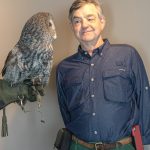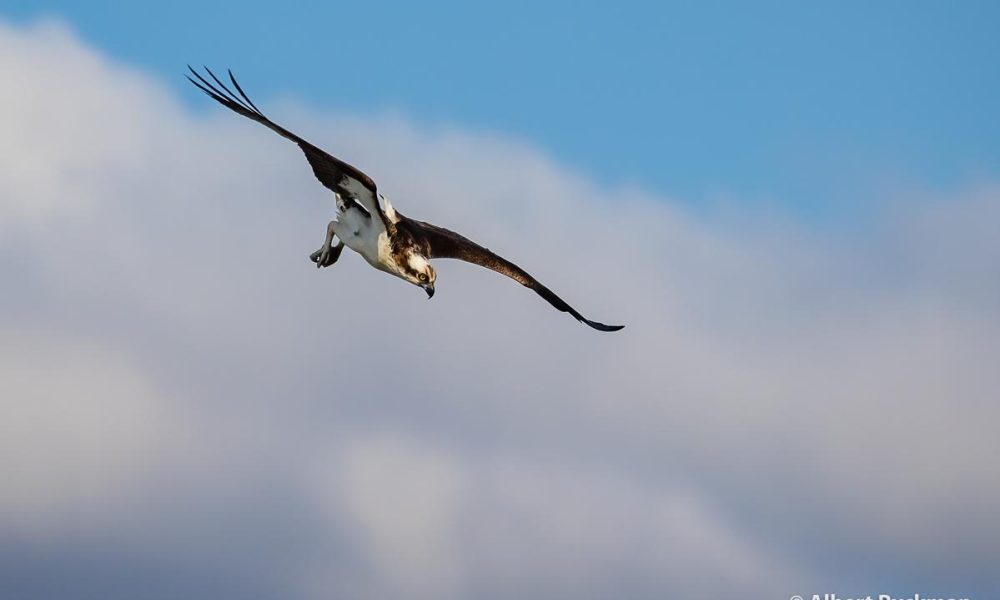The osprey is a large, flexible-winged hawk you can see over Salem. One may cruise above the Willamette, or be checking for fish at any local reservoir. Osprey feathers are dark brown (often seeming black) and white.
Along the Oregon Coast, osprey fish bays and estuaries, even the nearshore Pacific. One watches for movement beneath the surface, dives, and often catches its next fish. Sometimes the osprey plunges beneath the surface. No worry, this bird is especially waterproof and padded against injury. The wing tips may first resurface. Then those wings will soon lift the whole bird and its fish out of the water. The fish is carried in locked talons, head-first beneath the bird’s belly. Fish is nearly the entire osprey menu.
Osprey nest here in the Willamette Valley, and over most Oregon, wherever a fish-rich lake or river is nearby. Osprey build large, unruly stick piles for nesting. They will use tall trees, cliffs, and artificial platforms. A nest may be re-used for generations. In every case the nest needs to be high, safe from climbing predators and within commuting distance to good fishing. Strong, able fliers, osprey are fine with winging several miles from a nest to fish, then back. The food is so rich and protein-filled that an osprey can afford a twenty-mile round-trip commute for food. Most birds eating smaller, less rich fare must feed nearer to home.
The osprey will leave our valley before winter and return around March. There are three known nest sites in urban Salem: one at South Salem High School, another near the airport and one at the Audubon Nature Reserve in west Salem. There are more nests along the Willamette including Minto-Brown Island park, the Wheatland Ferry crossing and Buena Vista ferry crossing.
Some osprey facts:
- The osprey has been Oregon’s state raptor since 2017
- It is one of very few bird species found on every continent except Antarctic. Where there are fish, there shall be osprey to eat some.
- Their eyesight is superb, taking perfect measure of refracted light so the bird knows where the fish is, not where the light pretends it is.
- The osprey toes have barbed pads so they can grip the fish through its natural slime, and the osprey’s locked grip rarely fails.
- In 1972 the U.S. banned most uses of DDT, an early, popular pesticide. It was shown that DDT impaired some alpha predators from successful breeding—brown pelicans, bald eagles, osprey. Since the ban, the U.S. osprey population has rebounded.
- It’s been estimated a 20 year old osprey may have flown 200,000 miles it its lifetime.
- Many North American osprey go to South America over our winter. They do not ice fish.
This video by Lee French shows an osprey with lamprey, seen over the mouth of the Rogue River at Gold Beach in early August.
Correction: This article was updated to correct the location of the Audubon Nature Reserve. It is in west Salem, not east Salem.
STORY TIP OR IDEA? Send an email to Salem Reporter’s news team: [email protected].
JUST THE FACTS, FOR SALEM – We report on your community with care and depth, fairness and accuracy. Get local news that matters to you. Subscribe to Salem Reporter starting at $5 a month. Click I want to subscribe!

Harry Fuller is an Oregon birder and natural history author of three books: “Freeway Birding,” "Great Gray Owls of California, Oregon and Washington," and "San Francisco's Natural History--Sand Dunes to Streetcars." He leads birding trips for the Malheur Field Station. He is a member of the Salem Audubon Society, and leads bird trips locally. Harry has just published a new book, BIrding Harney County.









